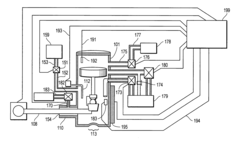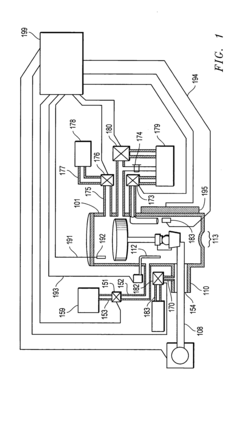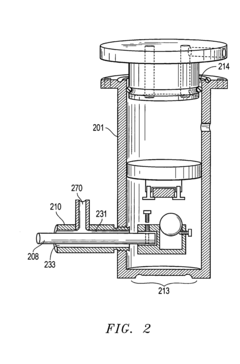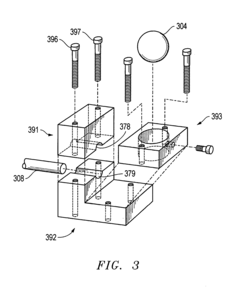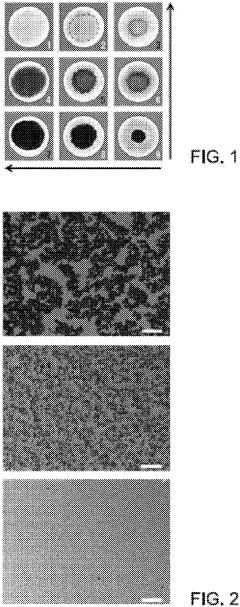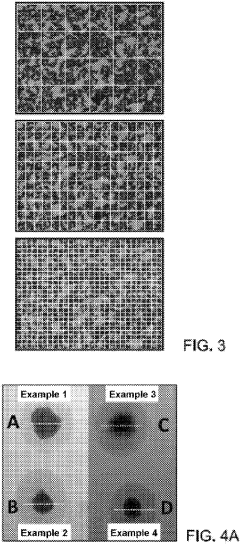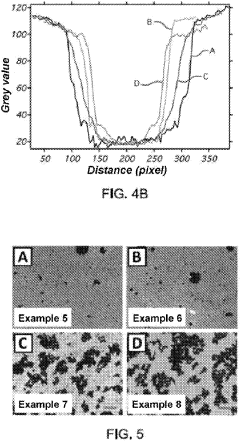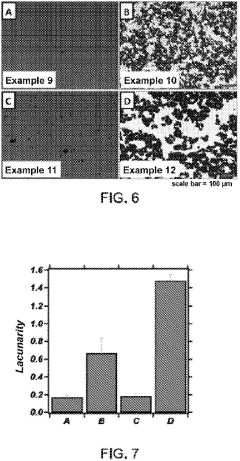V8 Engine Pressure Testing: Procedures and Benefits
JUL 4, 20259 MIN READ
Generate Your Research Report Instantly with AI Agent
Patsnap Eureka helps you evaluate technical feasibility & market potential.
V8 Engine Testing Background and Objectives
V8 engine pressure testing has been a critical aspect of automotive engineering since the introduction of V8 engines in the early 20th century. This testing procedure has evolved significantly over the decades, keeping pace with advancements in engine technology and performance requirements. The primary objective of V8 engine pressure testing is to evaluate and optimize the engine's performance, efficiency, and reliability under various operating conditions.
Historically, V8 engines have been widely used in high-performance vehicles, luxury cars, and heavy-duty trucks due to their power output and smooth operation. As environmental concerns and fuel efficiency standards have become more stringent, the focus of V8 engine development has shifted towards achieving higher power outputs while reducing fuel consumption and emissions. This shift has made pressure testing even more crucial in the engine development process.
The evolution of V8 engine pressure testing techniques has been driven by technological advancements in measurement and analysis tools. Early methods relied on basic mechanical gauges and visual inspections, while modern testing procedures utilize sophisticated electronic sensors, high-speed data acquisition systems, and advanced computer modeling. These technological improvements have enabled engineers to gather more accurate and comprehensive data on engine performance, leading to more refined and efficient V8 engines.
One of the key objectives of V8 engine pressure testing is to assess the combustion efficiency and power output across different operating conditions. This involves measuring cylinder pressures, fuel injection timing, and exhaust gas composition to optimize the engine's performance. Another critical goal is to evaluate the engine's durability and longevity by subjecting it to extreme pressure and temperature conditions that simulate real-world usage scenarios.
Pressure testing also plays a vital role in identifying potential design flaws or weaknesses in V8 engines before they reach production. By subjecting prototype engines to rigorous testing procedures, engineers can detect issues such as inadequate cooling, excessive wear, or structural weaknesses that may lead to premature failure or reduced performance. This proactive approach helps manufacturers improve the reliability and longevity of their V8 engines, ultimately benefiting consumers and enhancing brand reputation.
As the automotive industry continues to evolve, with a growing emphasis on electrification and alternative powertrains, the role of V8 engine pressure testing is adapting to new challenges. While traditional combustion engines may see a decline in market share, the knowledge and techniques developed through V8 engine testing continue to inform the development of more efficient and powerful engines across various configurations. Additionally, these testing methodologies are being applied to hybrid powertrains that combine V8 engines with electric motors, ensuring optimal performance and efficiency in these complex systems.
Historically, V8 engines have been widely used in high-performance vehicles, luxury cars, and heavy-duty trucks due to their power output and smooth operation. As environmental concerns and fuel efficiency standards have become more stringent, the focus of V8 engine development has shifted towards achieving higher power outputs while reducing fuel consumption and emissions. This shift has made pressure testing even more crucial in the engine development process.
The evolution of V8 engine pressure testing techniques has been driven by technological advancements in measurement and analysis tools. Early methods relied on basic mechanical gauges and visual inspections, while modern testing procedures utilize sophisticated electronic sensors, high-speed data acquisition systems, and advanced computer modeling. These technological improvements have enabled engineers to gather more accurate and comprehensive data on engine performance, leading to more refined and efficient V8 engines.
One of the key objectives of V8 engine pressure testing is to assess the combustion efficiency and power output across different operating conditions. This involves measuring cylinder pressures, fuel injection timing, and exhaust gas composition to optimize the engine's performance. Another critical goal is to evaluate the engine's durability and longevity by subjecting it to extreme pressure and temperature conditions that simulate real-world usage scenarios.
Pressure testing also plays a vital role in identifying potential design flaws or weaknesses in V8 engines before they reach production. By subjecting prototype engines to rigorous testing procedures, engineers can detect issues such as inadequate cooling, excessive wear, or structural weaknesses that may lead to premature failure or reduced performance. This proactive approach helps manufacturers improve the reliability and longevity of their V8 engines, ultimately benefiting consumers and enhancing brand reputation.
As the automotive industry continues to evolve, with a growing emphasis on electrification and alternative powertrains, the role of V8 engine pressure testing is adapting to new challenges. While traditional combustion engines may see a decline in market share, the knowledge and techniques developed through V8 engine testing continue to inform the development of more efficient and powerful engines across various configurations. Additionally, these testing methodologies are being applied to hybrid powertrains that combine V8 engines with electric motors, ensuring optimal performance and efficiency in these complex systems.
Market Demand for High-Performance V8 Engines
The market demand for high-performance V8 engines has been steadily growing, driven by a combination of factors including consumer preferences, technological advancements, and evolving industry trends. In the automotive sector, V8 engines continue to be highly sought after in luxury vehicles, sports cars, and high-end SUVs, where power and performance are key selling points. The robust torque and distinctive sound of V8 engines appeal to enthusiasts and performance-oriented consumers who prioritize driving experience over fuel efficiency.
In recent years, there has been a noticeable shift in the market dynamics for V8 engines. While environmental concerns and stricter emissions regulations have led to a general trend towards downsizing and electrification, the demand for high-performance V8 engines remains strong in specific segments. Manufacturers have responded by developing more efficient and technologically advanced V8 engines, incorporating features such as cylinder deactivation, direct injection, and turbocharging to improve fuel economy without sacrificing power.
The motorsport industry continues to be a significant driver of demand for high-performance V8 engines. In various racing series, including NASCAR, V8 Supercars, and certain classes of endurance racing, V8 engines remain the powerplant of choice. This not only sustains the market for specialized racing engines but also drives innovation that often trickles down to production vehicles.
In the marine sector, V8 engines are popular for high-performance boats and luxury yachts, where their power-to-weight ratio and reliability are highly valued. Similarly, in the aviation industry, there is a niche market for V8 engines in certain types of small aircraft and experimental planes.
The aftermarket and customization sectors also contribute significantly to the demand for high-performance V8 engines. Enthusiasts and custom car builders often seek out V8 engines for engine swaps, restorations, and performance upgrades, creating a thriving market for both new and remanufactured V8 engines.
Looking at market trends, while the overall automotive industry is shifting towards electrification, there remains a dedicated consumer base for high-performance internal combustion engines, particularly V8s. Manufacturers are adapting to this dual market reality by offering high-performance V8 models alongside hybrid and electric options in their lineups. This strategy allows them to cater to traditional performance enthusiasts while also meeting evolving environmental standards and consumer preferences.
In recent years, there has been a noticeable shift in the market dynamics for V8 engines. While environmental concerns and stricter emissions regulations have led to a general trend towards downsizing and electrification, the demand for high-performance V8 engines remains strong in specific segments. Manufacturers have responded by developing more efficient and technologically advanced V8 engines, incorporating features such as cylinder deactivation, direct injection, and turbocharging to improve fuel economy without sacrificing power.
The motorsport industry continues to be a significant driver of demand for high-performance V8 engines. In various racing series, including NASCAR, V8 Supercars, and certain classes of endurance racing, V8 engines remain the powerplant of choice. This not only sustains the market for specialized racing engines but also drives innovation that often trickles down to production vehicles.
In the marine sector, V8 engines are popular for high-performance boats and luxury yachts, where their power-to-weight ratio and reliability are highly valued. Similarly, in the aviation industry, there is a niche market for V8 engines in certain types of small aircraft and experimental planes.
The aftermarket and customization sectors also contribute significantly to the demand for high-performance V8 engines. Enthusiasts and custom car builders often seek out V8 engines for engine swaps, restorations, and performance upgrades, creating a thriving market for both new and remanufactured V8 engines.
Looking at market trends, while the overall automotive industry is shifting towards electrification, there remains a dedicated consumer base for high-performance internal combustion engines, particularly V8s. Manufacturers are adapting to this dual market reality by offering high-performance V8 models alongside hybrid and electric options in their lineups. This strategy allows them to cater to traditional performance enthusiasts while also meeting evolving environmental standards and consumer preferences.
Current Challenges in V8 Engine Pressure Testing
V8 engine pressure testing faces several significant challenges in the current automotive industry landscape. One of the primary issues is the complexity of modern V8 engines, which often incorporate advanced technologies such as direct injection, variable valve timing, and turbocharging. These features make it more difficult to accurately measure and analyze pressure within the engine cylinders.
Another challenge is the need for high-precision testing equipment capable of withstanding the extreme temperatures and pressures generated during V8 engine operation. The development and maintenance of such specialized equipment can be costly and time-consuming, potentially limiting the accessibility of comprehensive pressure testing for smaller automotive manufacturers or research facilities.
The increasing demand for fuel efficiency and reduced emissions has led to the development of more compact V8 engines with higher power densities. This trend presents challenges in terms of sensor placement and data acquisition, as there is less physical space within the engine to accommodate testing equipment without interfering with normal operation.
Variability in engine designs across different manufacturers and models also poses a challenge for standardization in pressure testing procedures. This lack of uniformity can make it difficult to compare results across different V8 engines and may require the development of custom testing protocols for each specific engine configuration.
The dynamic nature of engine operation, particularly under varying load conditions and RPM ranges, adds another layer of complexity to pressure testing. Capturing accurate pressure data across all operational states of a V8 engine requires sophisticated testing methodologies and data analysis techniques.
Furthermore, the interpretation of pressure testing data presents its own set of challenges. The vast amount of data generated during testing necessitates advanced analytics and visualization tools to extract meaningful insights. This requires not only specialized software but also skilled personnel capable of interpreting complex pressure waveforms and identifying potential issues or areas for optimization.
Lastly, the automotive industry's rapid pace of innovation means that pressure testing methodologies must continually evolve to keep up with new engine technologies. This constant need for adaptation can strain resources and require ongoing investment in research and development of testing procedures and equipment.
Another challenge is the need for high-precision testing equipment capable of withstanding the extreme temperatures and pressures generated during V8 engine operation. The development and maintenance of such specialized equipment can be costly and time-consuming, potentially limiting the accessibility of comprehensive pressure testing for smaller automotive manufacturers or research facilities.
The increasing demand for fuel efficiency and reduced emissions has led to the development of more compact V8 engines with higher power densities. This trend presents challenges in terms of sensor placement and data acquisition, as there is less physical space within the engine to accommodate testing equipment without interfering with normal operation.
Variability in engine designs across different manufacturers and models also poses a challenge for standardization in pressure testing procedures. This lack of uniformity can make it difficult to compare results across different V8 engines and may require the development of custom testing protocols for each specific engine configuration.
The dynamic nature of engine operation, particularly under varying load conditions and RPM ranges, adds another layer of complexity to pressure testing. Capturing accurate pressure data across all operational states of a V8 engine requires sophisticated testing methodologies and data analysis techniques.
Furthermore, the interpretation of pressure testing data presents its own set of challenges. The vast amount of data generated during testing necessitates advanced analytics and visualization tools to extract meaningful insights. This requires not only specialized software but also skilled personnel capable of interpreting complex pressure waveforms and identifying potential issues or areas for optimization.
Lastly, the automotive industry's rapid pace of innovation means that pressure testing methodologies must continually evolve to keep up with new engine technologies. This constant need for adaptation can strain resources and require ongoing investment in research and development of testing procedures and equipment.
Existing V8 Engine Pressure Testing Procedures
01 Pressure monitoring systems for V8 engines
Advanced pressure monitoring systems are developed for V8 engines to ensure optimal performance and efficiency. These systems utilize various sensors and control units to measure and regulate pressure in different engine components, such as the intake manifold, exhaust system, and oil circulation.- Pressure monitoring systems for V8 engines: Advanced pressure monitoring systems are developed for V8 engines to ensure optimal performance and prevent damage. These systems use sensors to measure various pressure points within the engine, providing real-time data to the engine control unit. This allows for precise adjustments to fuel injection, timing, and other parameters to maintain ideal pressure levels throughout the engine's operation.
- Pressure relief mechanisms in V8 engines: Innovative pressure relief mechanisms are implemented in V8 engines to prevent excessive pressure buildup. These mechanisms include pressure relief valves, bypass systems, and controlled venting techniques. By effectively managing pressure, these systems help to protect engine components, improve efficiency, and enhance overall engine longevity.
- Oil pressure management in V8 engines: Specialized oil pressure management systems are designed for V8 engines to ensure proper lubrication and cooling. These systems incorporate advanced oil pumps, pressure regulators, and distribution channels to maintain optimal oil pressure throughout the engine. Efficient oil pressure management contributes to reduced friction, improved engine performance, and increased durability.
- Turbocharging and pressure optimization for V8 engines: Turbocharging technologies are developed to enhance V8 engine performance by optimizing intake air pressure. These systems utilize advanced turbochargers, intercoolers, and electronic boost control mechanisms to precisely regulate the pressure of air entering the combustion chambers. This results in improved power output, fuel efficiency, and overall engine responsiveness.
- Combustion chamber pressure control in V8 engines: Innovative combustion chamber pressure control techniques are implemented in V8 engines to optimize the combustion process. These methods involve precise fuel injection timing, variable valve timing, and advanced ignition systems to manage in-cylinder pressure throughout the engine cycle. By controlling combustion chamber pressure, these systems improve engine efficiency, reduce emissions, and enhance overall performance.
02 Pressure optimization in fuel injection systems
Innovative fuel injection systems are designed to optimize pressure in V8 engines, improving fuel efficiency and power output. These systems incorporate high-precision injectors and advanced control algorithms to regulate fuel pressure and timing based on engine load and operating conditions.Expand Specific Solutions03 Turbocharging and supercharging pressure control
Turbocharging and supercharging technologies are employed in V8 engines to increase air pressure and enhance performance. These forced induction systems utilize sophisticated pressure control mechanisms to manage boost levels and prevent engine damage from excessive pressure.Expand Specific Solutions04 Oil pressure management in V8 engines
Advanced oil pressure management systems are developed for V8 engines to ensure proper lubrication and cooling. These systems incorporate pressure sensors, relief valves, and electronic control units to maintain optimal oil pressure across various engine operating conditions.Expand Specific Solutions05 Exhaust pressure control and optimization
Innovative exhaust pressure control systems are designed for V8 engines to improve performance and reduce emissions. These systems utilize variable geometry turbochargers, exhaust gas recirculation, and electronic control units to optimize back pressure and exhaust flow.Expand Specific Solutions
Key Players in V8 Engine Testing Industry
The V8 engine pressure testing market is in a mature stage, with established procedures and recognized benefits across the automotive industry. The global market size for engine testing equipment is substantial, driven by the continuous demand for high-performance and efficient engines. Technologically, the field is well-developed, with companies like Robert Bosch GmbH, Toyota Motor Corp., and Honda Motor Co., Ltd. leading innovation. These industry giants, along with Ford Global Technologies LLC and GM Global Technology Operations LLC, have significantly contributed to refining pressure testing techniques, enhancing engine reliability and performance. The competitive landscape is characterized by a mix of large automotive manufacturers and specialized testing equipment providers, all striving to improve testing accuracy and efficiency.
Robert Bosch GmbH
Technical Solution: Bosch has developed advanced V8 engine pressure testing procedures utilizing high-precision sensors and data analytics. Their system employs real-time monitoring of combustion chamber pressure, fuel injection pressure, and exhaust gas pressure throughout the engine cycle. This allows for precise calibration and optimization of engine performance. Bosch's testing protocol includes thermal shock tests, prolonged high-load runs, and rapid acceleration/deceleration cycles to evaluate engine durability and efficiency under extreme conditions[1][3]. The company has also integrated machine learning algorithms to analyze test data and predict potential failure points or areas for improvement in engine design.
Strengths: Highly accurate pressure sensors, comprehensive data analytics, and predictive maintenance capabilities. Weaknesses: High initial setup costs and complexity in data interpretation for non-specialists.
Toyota Motor Corp.
Technical Solution: Toyota's V8 engine pressure testing procedures focus on long-term reliability and efficiency. They utilize a combination of dynamometer testing and road simulations to evaluate engine performance under various conditions. Toyota's approach includes extended durability tests, often running engines continuously for thousands of hours to simulate years of real-world use[2]. Their testing protocols pay particular attention to thermal management, using advanced cooling systems and temperature sensors to monitor heat distribution across the engine block. Toyota also employs acoustic analysis during pressure testing to detect any abnormal sounds that might indicate potential issues with valves, pistons, or other components[4].
Strengths: Emphasis on long-term durability and real-world performance simulation. Weaknesses: Time-consuming testing process may delay product development cycles.
Core Innovations in Pressure Testing Technology
Method for testing properties of corrosive lubricants
PatentInactiveUS20050109130A1
Innovation
- A wear testing apparatus that maintains a sealed chamber using close tolerances and inert gas pressure to simulate engine conditions, eliminating the need for mechanical seals and preventing pressure excursions, allowing for safe testing of corrosive lubricating media at elevated temperatures and pressures.
Method for the assessment of the dispersing capacity of new or used lubricating compositions and of additives for lubricating compositions
PatentActiveUS20230168237A1
Innovation
- A laboratory-based method using optical microscopy and lacunarity analysis to assess the dispersing capacity of lubricating compositions and additives, involving the preparation of carbonaceous particulate dispersions and calculation of lacunarity, a parameter measuring image heterogeneity, to quantify dispersion efficiency without requiring engine tests.
Environmental Impact of V8 Engine Testing
The environmental impact of V8 engine testing is a critical consideration in the automotive industry, particularly as global focus shifts towards sustainability and reducing carbon emissions. V8 engine pressure testing, while essential for ensuring performance and reliability, can contribute significantly to environmental concerns if not managed properly.
One of the primary environmental issues associated with V8 engine testing is the emission of greenhouse gases and pollutants. During pressure testing, engines are often run for extended periods, consuming substantial amounts of fuel and releasing carbon dioxide, nitrogen oxides, and particulate matter into the atmosphere. These emissions contribute to air pollution and climate change, necessitating careful monitoring and mitigation strategies.
Water consumption and potential contamination present another environmental challenge. Cooling systems used in engine testing require large volumes of water, which may strain local water resources. Additionally, there is a risk of water contamination from oil, fuel, and other chemicals used in the testing process, potentially impacting local ecosystems if not properly managed.
Noise pollution is a significant concern, especially for testing facilities located near residential areas. The high-decibel output from V8 engines during pressure testing can disrupt local communities and wildlife, leading to potential conflicts and regulatory issues.
Energy consumption during testing procedures also contributes to the overall environmental footprint. The power required to run testing equipment, data acquisition systems, and facility operations can be substantial, often relying on non-renewable energy sources.
To address these environmental impacts, many automotive companies and testing facilities are implementing more sustainable practices. These include using advanced emissions control technologies, recycling water used in cooling systems, and investing in sound-dampening infrastructure. Some facilities are exploring the use of renewable energy sources to power their operations, reducing their carbon footprint.
Furthermore, there is a growing trend towards virtual testing and simulation technologies. These digital tools can significantly reduce the need for physical engine testing, thereby minimizing environmental impact while still providing valuable data on engine performance and durability.
As regulations become more stringent and public awareness of environmental issues increases, the automotive industry is under pressure to innovate in its testing procedures. This has led to the development of more efficient testing protocols that minimize resource consumption and emissions while still ensuring the reliability and performance of V8 engines.
In conclusion, while V8 engine pressure testing remains crucial for automotive development, its environmental impact cannot be overlooked. The industry's challenge lies in balancing the need for thorough testing with the imperative to reduce environmental harm, driving innovation in both engine technology and testing methodologies.
One of the primary environmental issues associated with V8 engine testing is the emission of greenhouse gases and pollutants. During pressure testing, engines are often run for extended periods, consuming substantial amounts of fuel and releasing carbon dioxide, nitrogen oxides, and particulate matter into the atmosphere. These emissions contribute to air pollution and climate change, necessitating careful monitoring and mitigation strategies.
Water consumption and potential contamination present another environmental challenge. Cooling systems used in engine testing require large volumes of water, which may strain local water resources. Additionally, there is a risk of water contamination from oil, fuel, and other chemicals used in the testing process, potentially impacting local ecosystems if not properly managed.
Noise pollution is a significant concern, especially for testing facilities located near residential areas. The high-decibel output from V8 engines during pressure testing can disrupt local communities and wildlife, leading to potential conflicts and regulatory issues.
Energy consumption during testing procedures also contributes to the overall environmental footprint. The power required to run testing equipment, data acquisition systems, and facility operations can be substantial, often relying on non-renewable energy sources.
To address these environmental impacts, many automotive companies and testing facilities are implementing more sustainable practices. These include using advanced emissions control technologies, recycling water used in cooling systems, and investing in sound-dampening infrastructure. Some facilities are exploring the use of renewable energy sources to power their operations, reducing their carbon footprint.
Furthermore, there is a growing trend towards virtual testing and simulation technologies. These digital tools can significantly reduce the need for physical engine testing, thereby minimizing environmental impact while still providing valuable data on engine performance and durability.
As regulations become more stringent and public awareness of environmental issues increases, the automotive industry is under pressure to innovate in its testing procedures. This has led to the development of more efficient testing protocols that minimize resource consumption and emissions while still ensuring the reliability and performance of V8 engines.
In conclusion, while V8 engine pressure testing remains crucial for automotive development, its environmental impact cannot be overlooked. The industry's challenge lies in balancing the need for thorough testing with the imperative to reduce environmental harm, driving innovation in both engine technology and testing methodologies.
Safety Protocols in Engine Pressure Testing
Safety protocols are paramount in engine pressure testing, particularly for V8 engines, due to the high pressures and potential risks involved. These protocols are designed to protect personnel, equipment, and the integrity of the test results. The first line of defense is proper personal protective equipment (PPE). All personnel involved in pressure testing must wear safety glasses, hearing protection, and appropriate clothing, including closed-toe shoes and flame-resistant garments.
Before initiating any test, a comprehensive safety briefing should be conducted to ensure all team members are aware of potential hazards and emergency procedures. The testing area must be clearly marked and access restricted to authorized personnel only. Proper ventilation is crucial to prevent the accumulation of exhaust gases and potential fire hazards.
Equipment safety checks are essential before each test. This includes inspecting all pressure lines, fittings, and gauges for signs of wear or damage. Pressure relief valves must be properly calibrated and functional to prevent over-pressurization. The engine mount and dynamometer setup should be secure and capable of withstanding the forces generated during testing.
During the test, constant monitoring of pressure levels, temperature, and engine performance is critical. Automated safety systems should be in place to shut down the engine if predetermined safety thresholds are exceeded. A dedicated safety observer should be present to monitor the test and initiate emergency procedures if necessary.
Emergency protocols must be well-established and rehearsed. This includes procedures for rapid engine shutdown, fire suppression, and personnel evacuation. Fire extinguishers and first aid kits should be readily accessible in the testing area.
Post-test safety measures are equally important. The engine and testing equipment must be allowed to cool down before any inspection or maintenance is performed. Proper disposal procedures for used fluids and materials should be followed to prevent environmental contamination.
Documentation of all safety procedures and any incidents is crucial for continuous improvement of safety protocols. Regular safety audits and updates to procedures based on new information or technologies help maintain the highest standards of safety in engine pressure testing.
By adhering to these comprehensive safety protocols, the risks associated with V8 engine pressure testing can be significantly mitigated, ensuring the well-being of personnel and the reliability of test results.
Before initiating any test, a comprehensive safety briefing should be conducted to ensure all team members are aware of potential hazards and emergency procedures. The testing area must be clearly marked and access restricted to authorized personnel only. Proper ventilation is crucial to prevent the accumulation of exhaust gases and potential fire hazards.
Equipment safety checks are essential before each test. This includes inspecting all pressure lines, fittings, and gauges for signs of wear or damage. Pressure relief valves must be properly calibrated and functional to prevent over-pressurization. The engine mount and dynamometer setup should be secure and capable of withstanding the forces generated during testing.
During the test, constant monitoring of pressure levels, temperature, and engine performance is critical. Automated safety systems should be in place to shut down the engine if predetermined safety thresholds are exceeded. A dedicated safety observer should be present to monitor the test and initiate emergency procedures if necessary.
Emergency protocols must be well-established and rehearsed. This includes procedures for rapid engine shutdown, fire suppression, and personnel evacuation. Fire extinguishers and first aid kits should be readily accessible in the testing area.
Post-test safety measures are equally important. The engine and testing equipment must be allowed to cool down before any inspection or maintenance is performed. Proper disposal procedures for used fluids and materials should be followed to prevent environmental contamination.
Documentation of all safety procedures and any incidents is crucial for continuous improvement of safety protocols. Regular safety audits and updates to procedures based on new information or technologies help maintain the highest standards of safety in engine pressure testing.
By adhering to these comprehensive safety protocols, the risks associated with V8 engine pressure testing can be significantly mitigated, ensuring the well-being of personnel and the reliability of test results.
Unlock deeper insights with Patsnap Eureka Quick Research — get a full tech report to explore trends and direct your research. Try now!
Generate Your Research Report Instantly with AI Agent
Supercharge your innovation with Patsnap Eureka AI Agent Platform!
